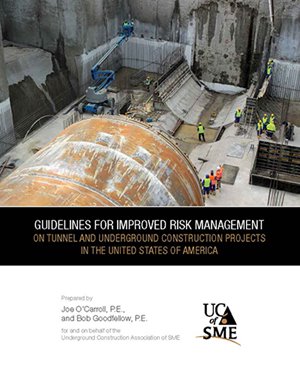|
While adopting the principles and intent of the ITIG Code of Practice, the publication of this GIRM recognizes that there are unique differences that apply to projects undertaken in the United States of America (USA). In other countries, codes and standards are generally universal for the country in which they are being adopted. In the USA, different states and even cities have differing statutory requirements and other legal constraints with respect to procurement of contracts and contracting methodologies. While there might always be exceptions based on new or idiosyncratic laws in local jurisdictions, the intent of this publication is to provide general guidelines that should be acceptable irrespective of the USA state or city in which tunnel and underground construction projects are being planned, designed, procured and constructed.
|
If all parties to a USA project follow this GIRM, the authors believe that the outcome will be to reduce adversarial relationships between participants while promoting the minimization and management of risks associated with the design and construction of tunnels, caverns, shafts, and associated underground structures. It is not intended to be a “Code” nor a Contract Document, but if these guidelines are adopted, it should give project Owners, Planners, Designers, Contractors, and Insurers a much better understanding of the wide range and importance of risks (and opportunities) associated with the project and provide greater confidence for delivering a successful project.
The authors wish to thank the Owners’, Designers’, Contractors’, and Insurers’ personnel involved in various tunnel and underground construction projects who kindly provided their time to review, comment, make recommendations, and ultimately accept this publication as their industry-recommended guidelines for improved risk management in the USA.
This GIRM reflects the consensus of a wide variety of industry experts and other professionals involved in the tunnel and underground construction industry in the USA. As such, the authors believe that it describes the best practices to generally manage and reduce risk in USA tunnel and underground construction projects. Users of this GIRM must appreciate, however, that no risk management regimen is perfect, and that the varying circumstances, conditions, and locations of different projects, including variances in local laws and regulations, may require additional or different risk management practices to further improve safety and better manage risk. The Society for Mining, Metallurgy & Exploration (SME), and its division, the Underground Construction Association (UCA), expressly disclaim any liability of SME, the UCA, their respective officers, directors, members, employees, associates, servants, or agents, including the authors, reviewers, or other individual experts and technical committees associated with the publication of this GIRM, for any claims, losses, damages, remedies, or damages arising from, related to, or caused by, directly or indirectly, the use of or reliance on any guidance, recommendations, or other information in this GIRM, including but not limited to pecuniary losses, damages, claims, or other liabilities arising from personal injury, property damage, or other harm of any nature whatsoever, whether direct or indirect, or for costs (including legal fees) and expenses related thereto.
UCA may revise this publication from time to time to reflect recent developments or changes to existing standards but does not undertake to do so on any regular or continuous basis. Users are therefore reminded to note the date of this version and to take reasonable steps to identify any post-publication developments or changes that may affect risk management for their projects.


